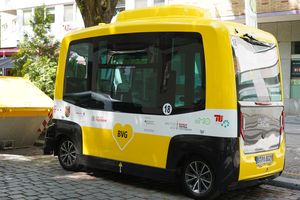KANBrief 1/23

Growing numbers of companies are using driverless vehicles. The requirements and conditions applicable to their use however often give rise to uncertainty. The Fachbereich AKTUELL FBHM 119 publication provides manufacturers and operators of such vehicles in a range of sectors with assistance in the design and safe use of automated vehicles.
Vehicles are of crucial economic significance in modern industry and the trades, and they are used in the most diverse of applications. A wide range of vehicle categories and types exists, extending from general vehicles for the movement of goods and people, to special applications for particular operating scenarios and conditions and in combination with further functionality. Together, the development of highly automated systems for performance of the driving task, and the wide range of applications of these systems, result in the most diverse of requirements for safety and health, particularly when vehicles are operated without drivers.
In 2021, the German Road Traffic Act (StVG) was amended and supplemented by the Act on Autonomous Driving. This was followed by a regulation (in German) governing the technical requirements and the procedure for the registration of autonomous (driverless) vehicles. Driverless, automated applications in industrial and trade environments often fall outside the scope of the StVG. Its provisions are therefore often not binding under these circumstances.
At present, state regulations and those of the German Social Accident Insurance contain virtually no requirements concerning automated vehicles and mobile machinery. In the body of standards, only EN ISO 3691-4, Industrial trucks – Safety requirements and verification – Part 4: Driverless industrial trucks and their systems, is relevant to applications of this technology in industrial and trade environments. However, the operation of driverless vehicles often extends beyond the scope of this standard. This is the case for example when other categories of vehicle or more complex operating conditions are concerned, such as at intersections or in environments shared with conventional traffic.
Fachbereich AKTUELL FBHM-119 (in German) on the subject of driverless vehicles in industrial and trade environments, published in March 2022, provides guidance on identifying the requirements for preventive measures in this context. The publication was produced jointly by several committees and institutes of the German Social Accident Insurance (DGUV), the German Road Safety Council (DVR) and the Federal Institute for Occupational Safety and Health (BAuA), and in coordination with vehicle manufacturers and operators. It recognizes that the requirements to be met by automated vehicles used in industrial and trade environments differ widely depending on the area of application concerned. This must be taken into account by the operational risk assessment. Fachbereich AKTUELL FBHM-119 identifies three different categories of industrial and trade environment:
In environments accessible to the public and equivalent environments, regulations comparable to those for public roads must apply. Automated vehicles must meet the technical requirements for use on public roads.
In safeguarded spaces to which persons do not have access, the applicable requirements are the same as those for automated production facilities. Access by persons must be prevented reliably, for example by means of guards. Where persons must enter the space to conduct maintenance or repairs, special protective measures must be taken.
The focus of Fachbereich AKTUELL FBHM-119 lies upon safeguarded areas to which access is restricted. Examples of such areas are production or assembly areas, and any other industrial or trade environments to which access is controlled and limited to certain persons and vehicles. Access control constrains the group of persons and objects to be considered in the area concerned. These persons and objects must be reliably detected and all anticipated traffic situations reliably controlled. A special risk assessment must be conducted in which the anticipated obstacles and traffic must be determined, together with the complexity of the driverless traffic. The typical requirements for the use case concerned can then be determined in a matrix. These requirements are however not exhaustive, and must always be verified on a case-by-case basis and expanded if necessary.
Fachbereich AKTUELL FBHM-119 also describes requirements concerning the functional safety of the automated driving function. Reference is made to normative design principles for functional safety, such as EN ISO 13849-1, Safety of machinery – Safety-related parts of control systems, Part 1: General principles for design and EN 61508, Functional safety of safety-related electrical/electronic/programmable electronic systems.
Progressive developments in the field of automated driving revealed at an early stage the need for the topic to be monitored continually. For this reason, the Automated driving in operational environments Working group was formed in the Subcommittee Vehicle construction, drive systems, maintenance (SG FAI) of the DGUV Committee Woodworking and metalworking. The working group comprises members of the project group responsible for drawing up Fachbereich AKTUELL FBHM-119, together with other specialists. KAN maintains close contact with the working group and supports it in all matters relating to standardization in this field. The common objective is to define boundary points for standardization and formulate common positions that are submitted to the standardization process and influence it.
Sven Träger
German Social Accident, Insurance Institution for the woodworking and metalworking industries
DGUV Subcommittee Vehicle construction,drive systems, maintenance (in German)